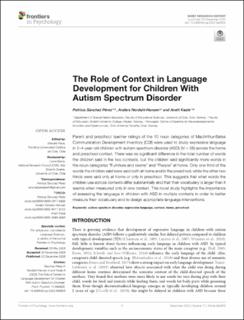| dc.contributor.author | Sánchez Pérez, Patricia | |
| dc.contributor.author | Nordahl-Hansen, Anders Johan | |
| dc.contributor.author | Kaale, Anett | |
| dc.date.accessioned | 2021-01-30T22:22:24Z | |
| dc.date.available | 2021-01-30T22:22:24Z | |
| dc.date.created | 2021-01-11T20:23:04Z | |
| dc.date.issued | 2020 | |
| dc.identifier.citation | Frontiers in Psychology. 2020, 11:563925 | |
| dc.identifier.issn | 1664-1078 | |
| dc.identifier.uri | https://hdl.handle.net/11250/2725436 | |
| dc.description.abstract | Parent and preschool teacher ratings of the 10 noun categories of MacArthur-BatesCommunication Development Inventory (CDI) were used to study expressive languagein 2–4-year-old children with autism spectrum disorder (ASD) (N= 58) across the homeand preschool context. There was no significant difference in the total number of wordsthe children said in the two contexts, but the children said significantly more words inthe noun categories “Furniture and rooms” and “People” at home. Only one third of thewords the children said were said both at home and in the preschool, while the other twothirds were said only at home or only in preschool. This suggests that what words thechildren use across contexts differ substantially and that their vocabulary is larger than itseems when measured only in one context. This novel study highlights the importanceof assessing the language in children with ASD in multiple contexts in order to bettermeasure their vocabulary and to design appropriate language interventions. | en_US |
| dc.language.iso | eng | en_US |
| dc.publisher | Frontiers | en_US |
| dc.rights | Navngivelse 4.0 Internasjonal | * |
| dc.rights.uri | http://creativecommons.org/licenses/by/4.0/deed.no | * |
| dc.subject | autism spectrum disorder | en_US |
| dc.subject | expressive language | en_US |
| dc.subject | context | en_US |
| dc.subject | home | en_US |
| dc.subject | preschool | en_US |
| dc.title | The Role of Context in Language Development for Children With Autism Spectrum Disorder | en_US |
| dc.type | Peer reviewed | en_US |
| dc.type | Journal article | en_US |
| dc.description.version | publishedVersion | en_US |
| dc.subject.nsi | VDP::Samfunnsvitenskap: 200::Psykologi: 260::Kognitiv psykologi: 267 | en_US |
| dc.subject.nsi | VDP::Samfunnsvitenskap: 200::Pedagogiske fag: 280::Spesialpedagogikk: 282 | en_US |
| dc.source.volume | 11 | en_US |
| dc.source.journal | Frontiers in Psychology | en_US |
| dc.identifier.doi | https://doi.org/10.3389/fpsyg.2020.563925 | |
| dc.identifier.cristin | 1869403 | |
| dc.source.articlenumber | 563925 | en_US |
| cristin.ispublished | true | |
| cristin.fulltext | original | |
| cristin.qualitycode | 2 | |

